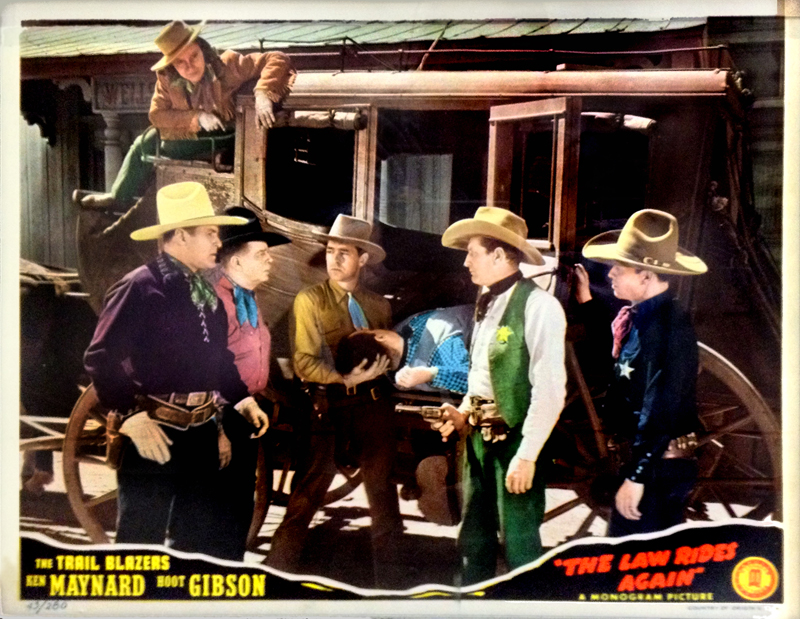|
|
Melody Ranch | Placerita Canyon

Click image to enlarge
Lobby card for "The Law Rides Again" (Monogram Pictures, 1943), starring Ken Maynard (left) and Hoot Gibson (second from left). Filmed at the Monogram Ranch (later called Melody Ranch) in Placerita Canyon, and at Corriganville in Simi Valley. Maynard, Gibson and other major Western stars of the 1920s were still big enough box-office draws in the 1940s to pull a Saturday matinee crowd. They teamed up for "trio pictures" — in the instance of Maynard and Gibson, they were the Monogram's Trail Blazers, with Bob Steele or Chief Thundercloud (here) rounding out the trio. "The Law Rides Again" is produced by Robert Emmett Tansey, directed by Alan James; players include Jack La Rue, Betty Miles, Emmett Lynn, Kenneth Harlan, Chief Thundercloud, Chief Many Treaties, Bryant Washburn, Fred Hoose, Kenne Duncan, Roy Brent, John Bridges, John Merton, Hank Bell, Charles Murray Jr., Steve Clark, Budd Buster, Foxy Callahan, Chick Hannan and Wally West. Further reading: Melody Ranch: Movie Magic in Placerita Canyon.
About Hoot Gibson.
Edmund Richard Gibson earned the nickname "Hoot" when he worked as a messenger for the Owl Drug Co. He was born August 6, 1892, in Tekamah, Nebraska and appeared in more than 200 films (including short features) between 1910, when he earned $50 for his role in "The Two Brothers," and 1960, when he made an uncredited appearance in "Ocean's Eleven." Gibson did most of his work as a silent cowboy actor between World War I and the early 1930s. He directed a bit in 1920-21 and produced some of his own films from 1923-30. The 5'9" Hollywood giant died of cancer on August 23, 1962, in Woodland Hills — five days before a wildfire burned down Gene Autry's Melody Ranch in Placerita Canyon, where Gibson made some of his movies. In addition to using the Santa Clarita Valley as a backdrop for filming, during the time he was married to Dorothea Sally Eilers (a popular leading lady in late silents and early talkies), he owned a ranch in Saugus now known as the Saugus Speedway. SCV historian Jerry Reynolds writes: "Roy Baker purchased a 40-acre tract east of Bouquet Junction during 1923, starting construction on a rodeo arena a year later. Hoot Gibson bought the ranch and stadium in 1930, putting on shows that attracted such stars as Tom Mix, John Wayne and Clark Gable. In 1934 Gibson sold out to Paul Hill, who ran the Western Livestock yards and leased it to film companies for three years until a huge flood filled the home and arena with mud and debris. (Hill) was unable to make payments, and the bank repossessed the property, which was eventually taken over by a professor of economics at Occidental College, William Bonelli (who started the Santa Clarita Water Co. and built one of the first local housing tracts in the late 1940s). Today (the rodeo arena) is known as the Saugus Speedway."
LW2328: 9600 dpi jpeg from digital image of original lobby card |
The site owner makes no assertions as to ownership of any original copyrights to digitized images. However, these images are intended for Personal or Research use only. Any other kind of use, including but not limited to commercial or scholarly publication in any medium or format, public exhibition, or use online or in a web site, may be subject to additional restrictions including but not limited to the copyrights held by parties other than the site owner. USERS ARE SOLELY RESPONSIBLE for determining the existence of such rights and for obtaining any permissions and/or paying associated fees necessary for the proposed use.







